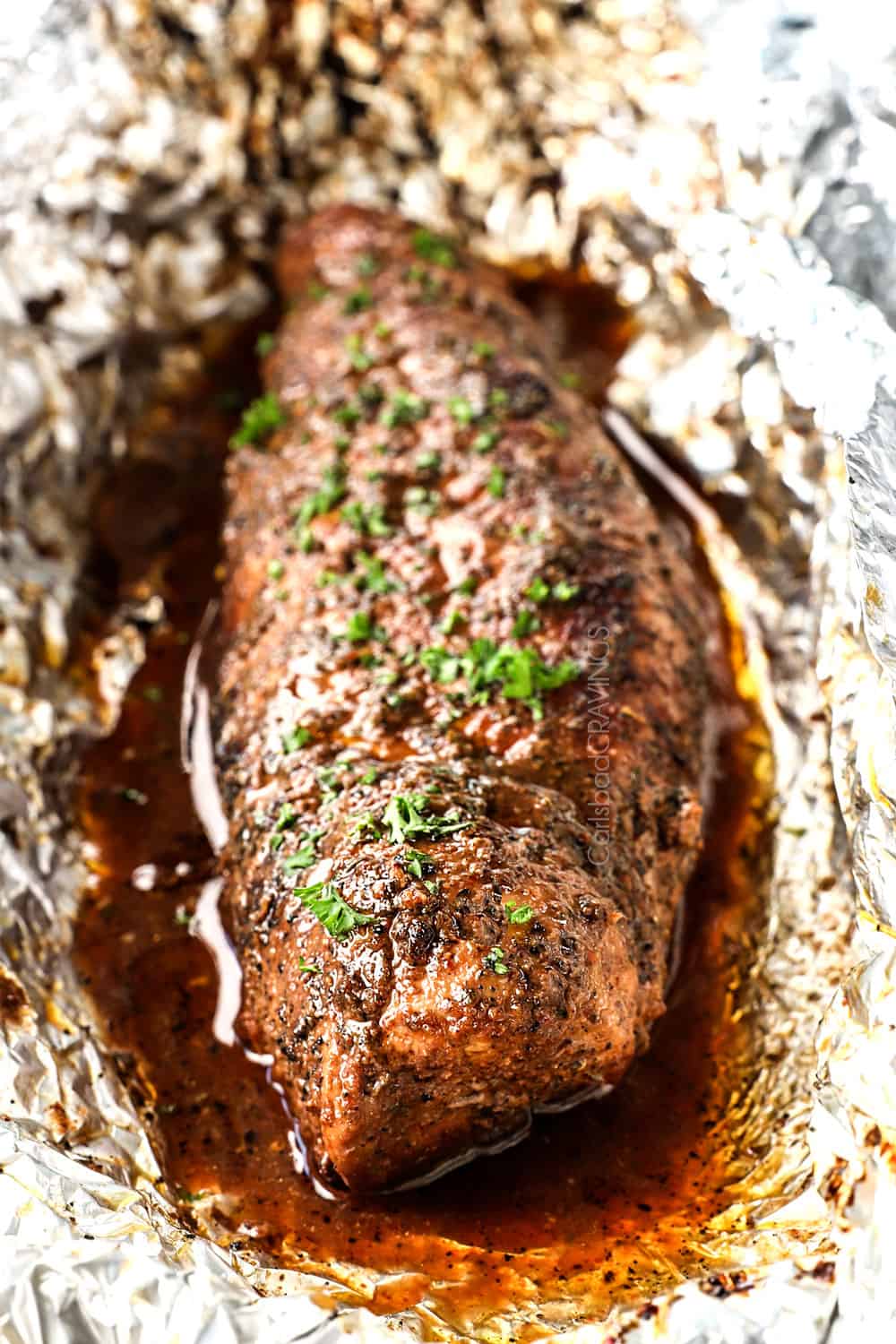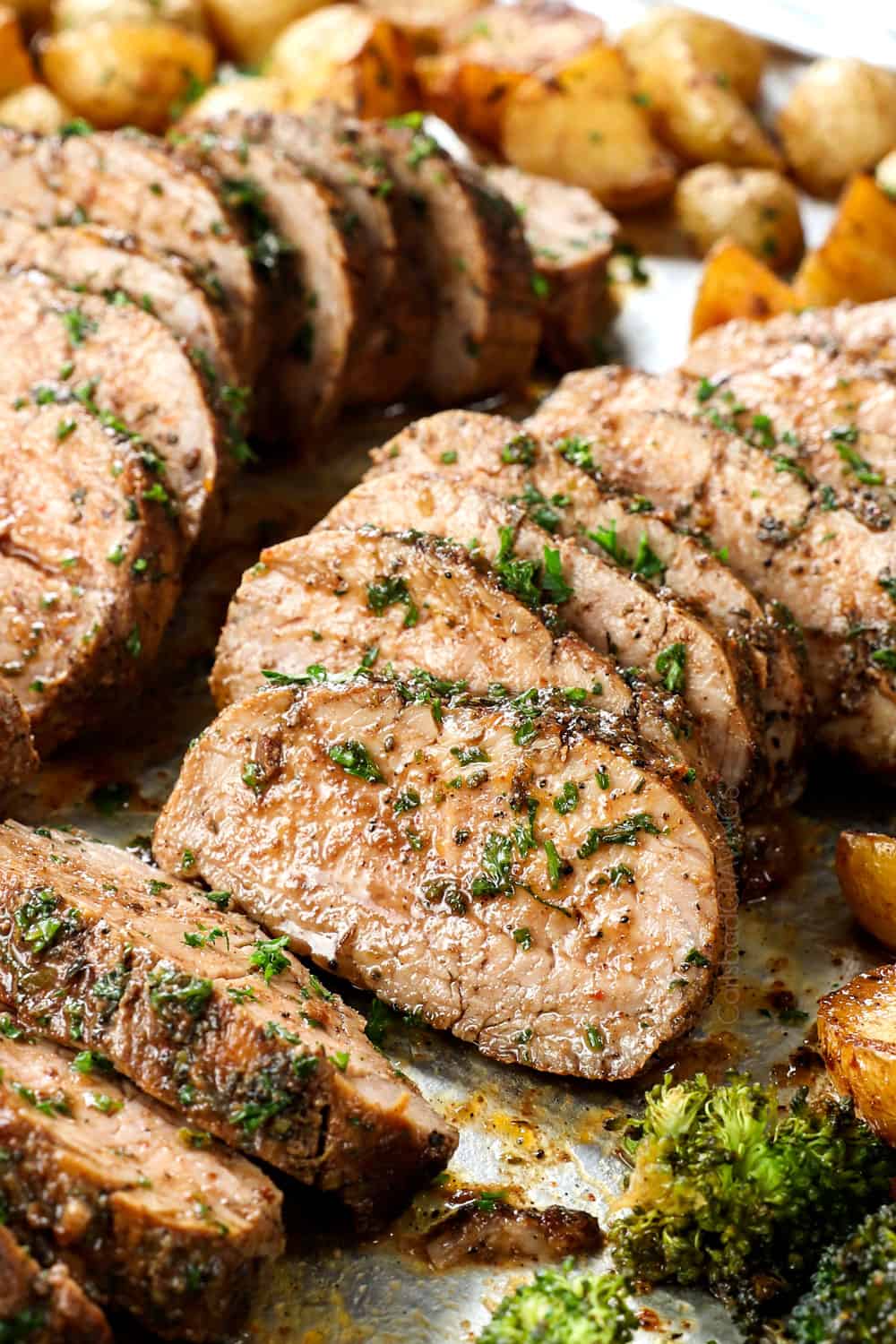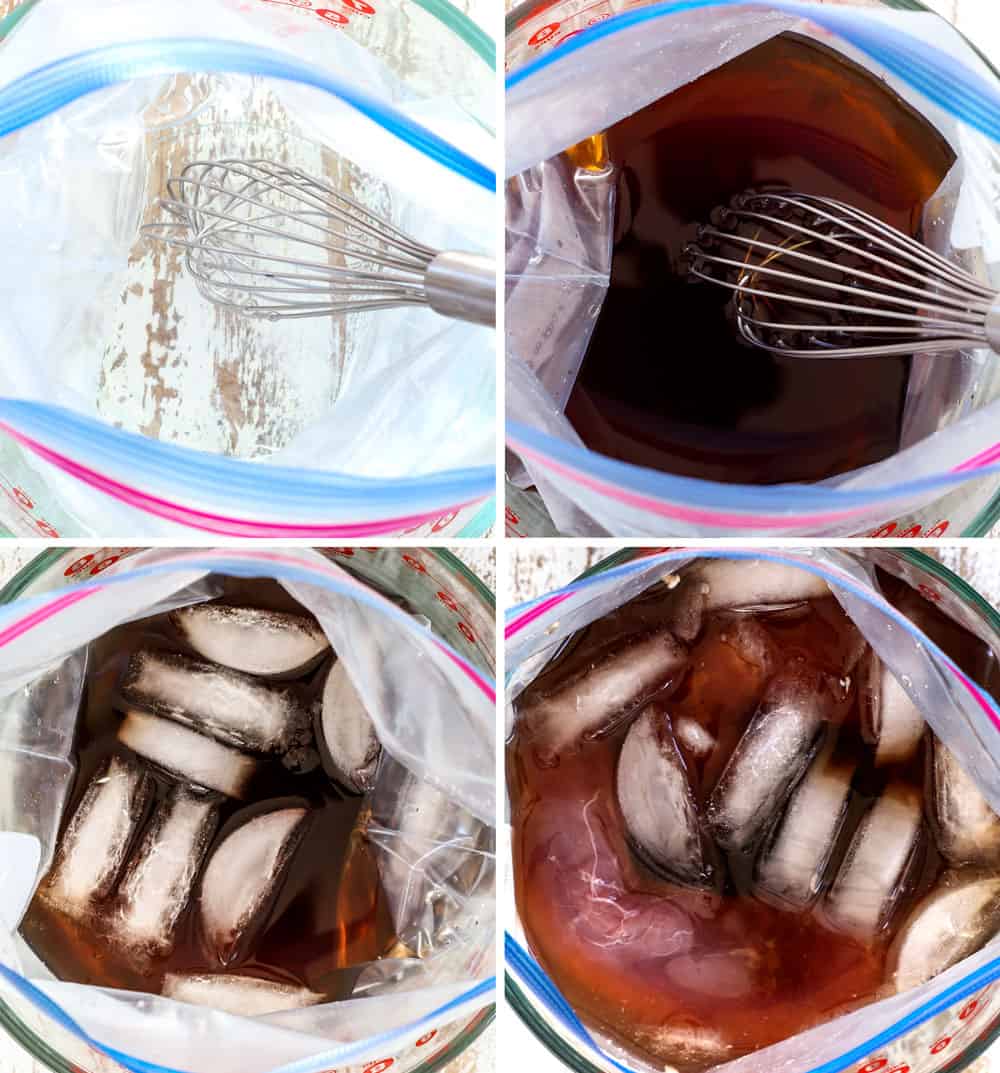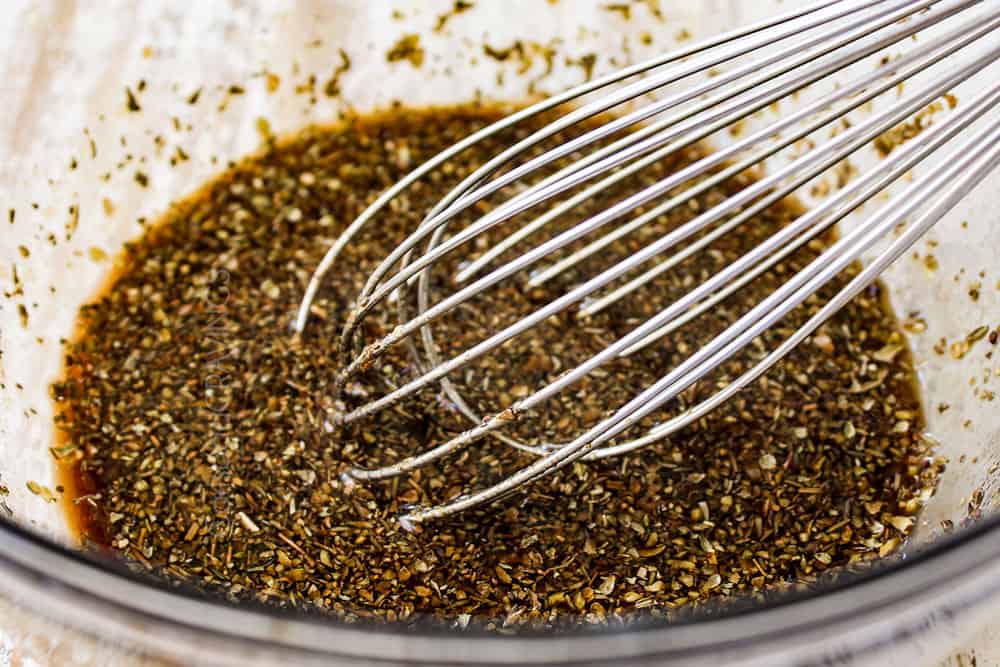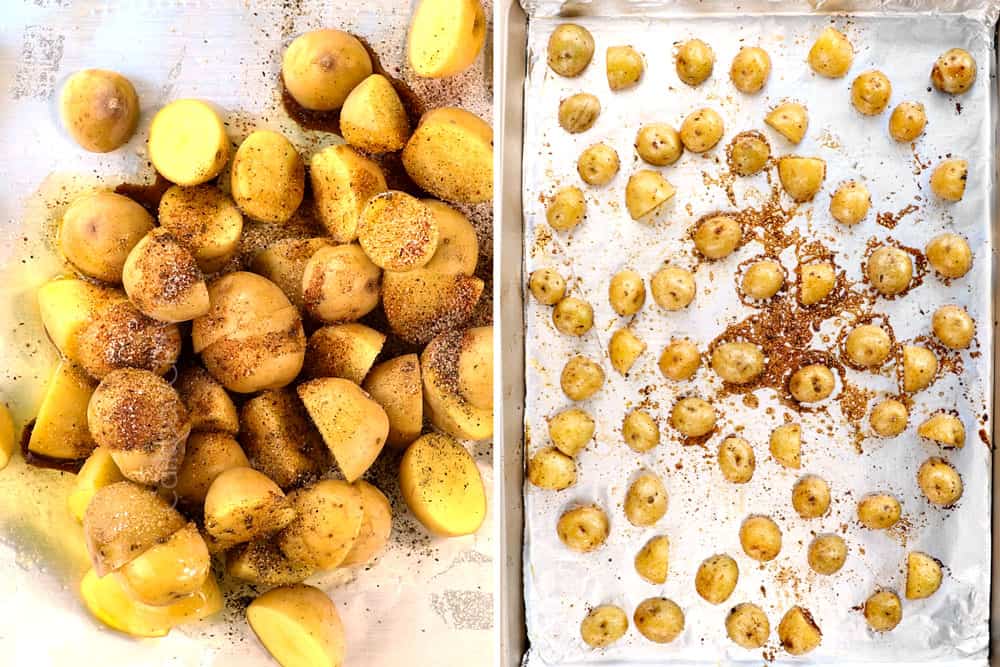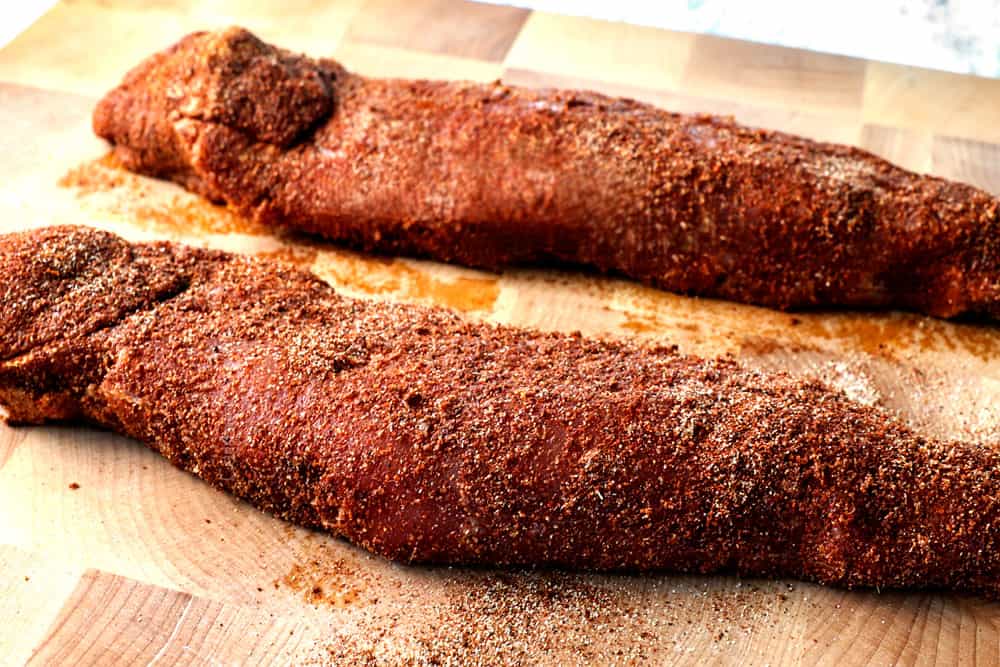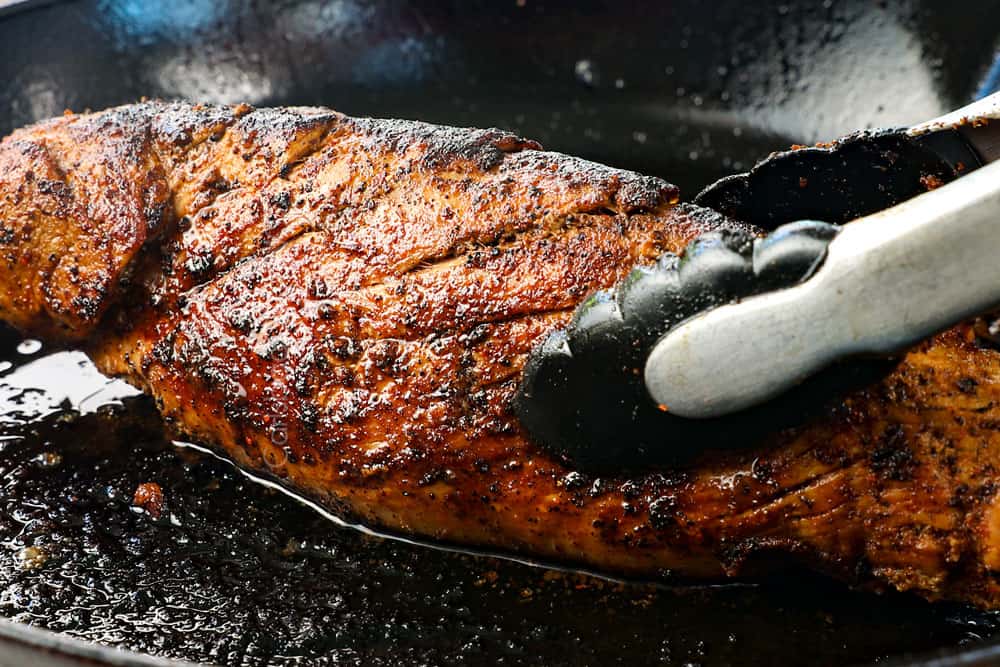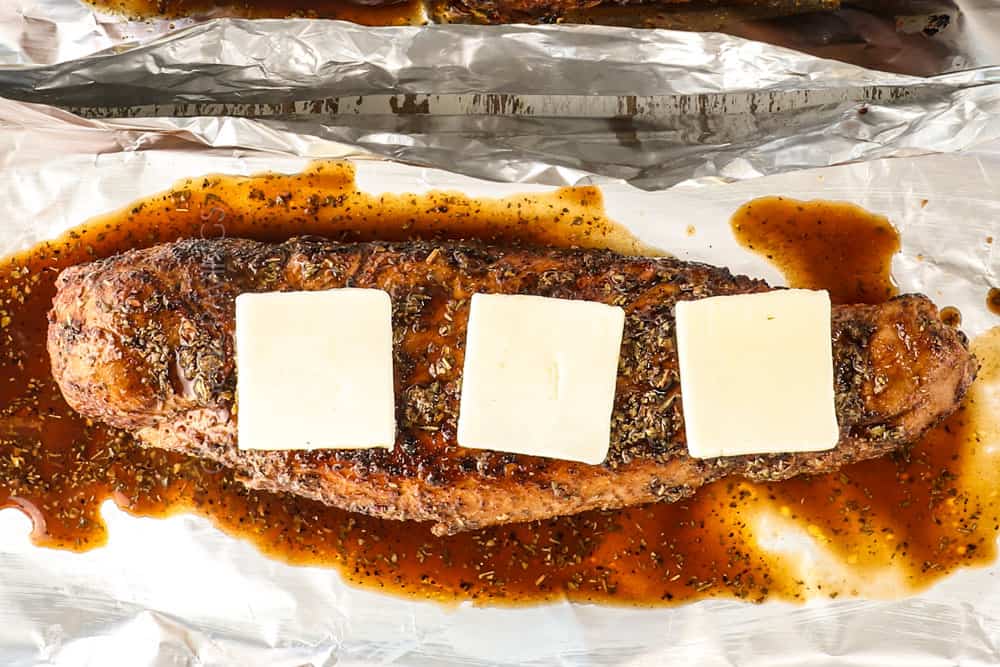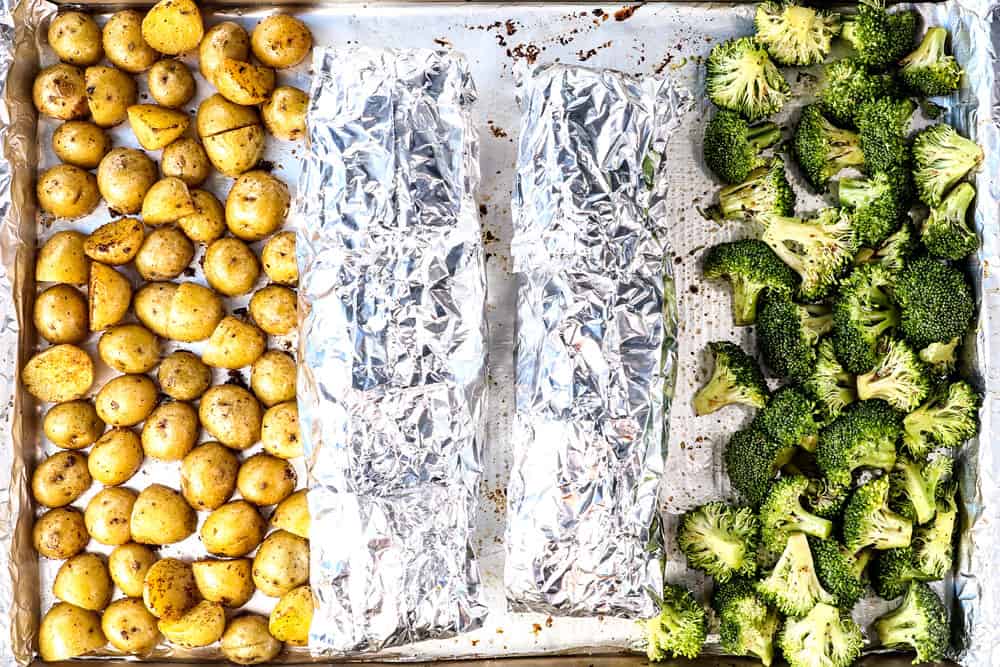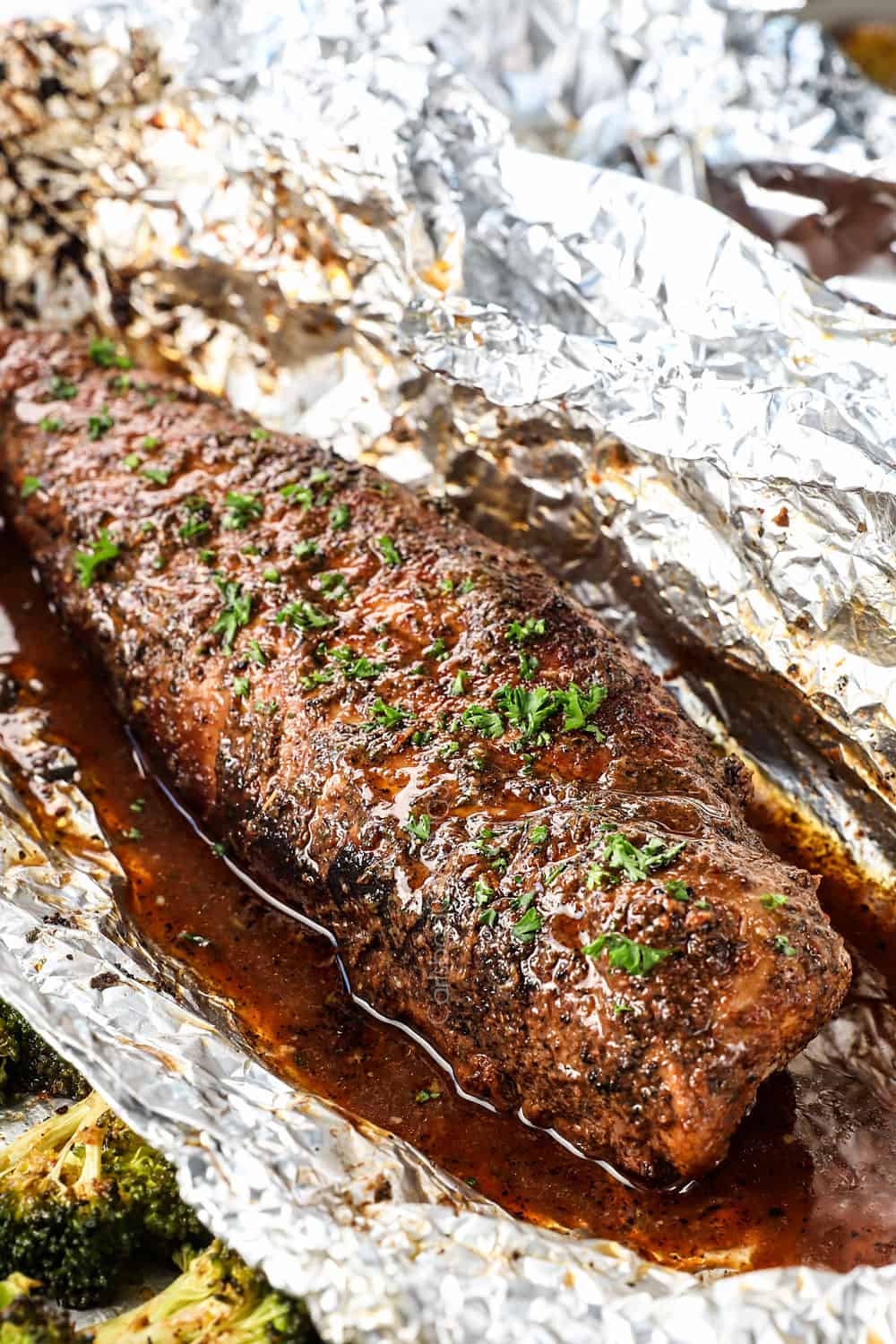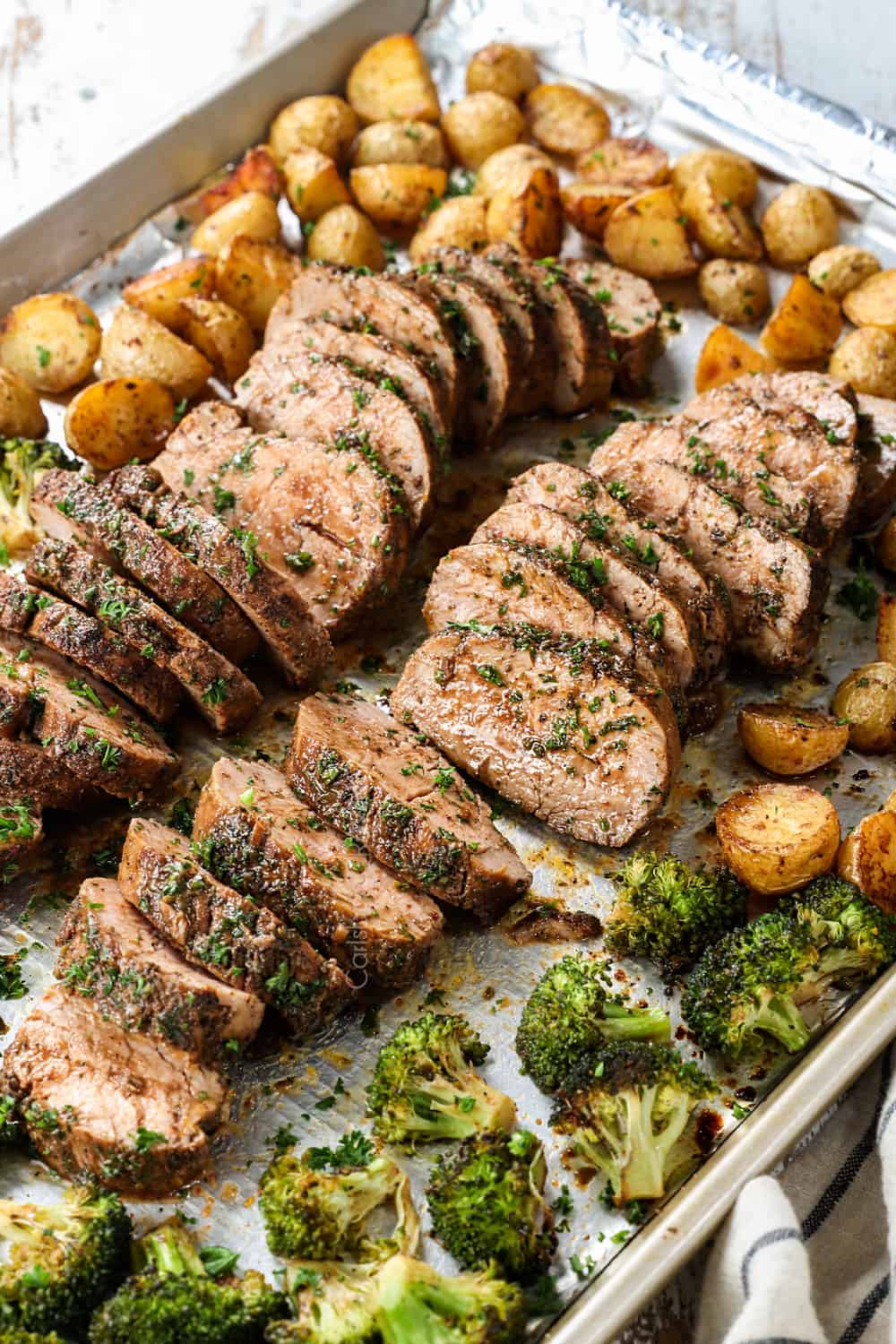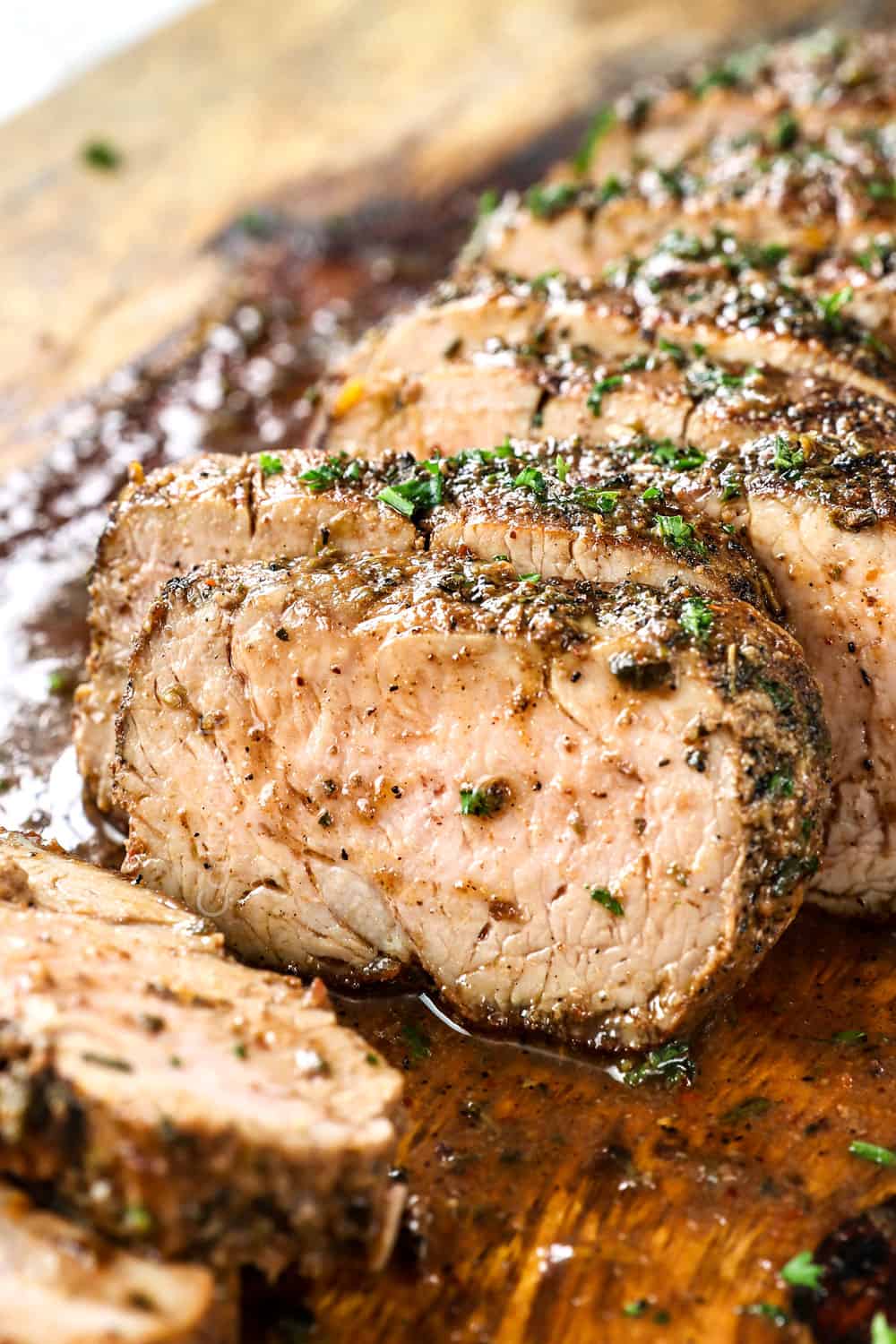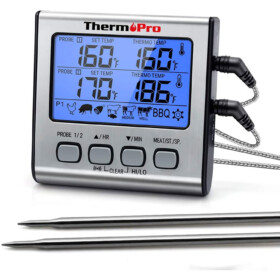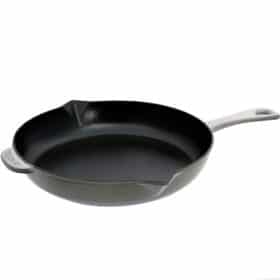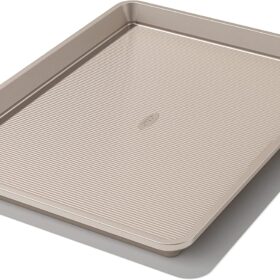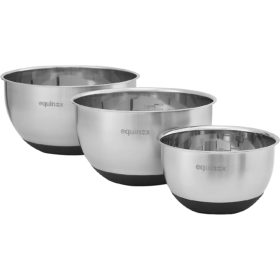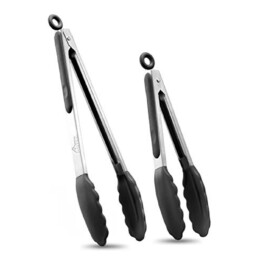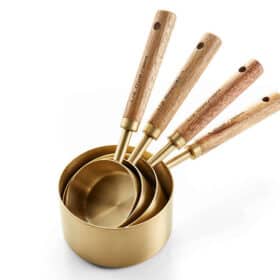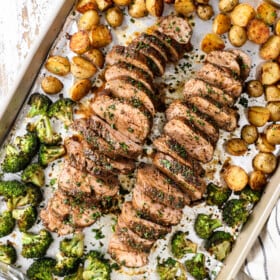Pork tenderloin is a lean, delicious, easy alternative to chicken and a chameleon when it comes to flavorings. Don’t miss our favorite pork tenderloin recipes: Garlic Lemon Butter Pork Tenderloin, Roasted Hoisin Blackberry Pork Tenderloin and Chili Dijon Pork Tenderloin. If you’re looking for a slow cooker option my honey pork loin recipe is also fantastic (note that recipe is for loin and not tenderloin).
PIN THIS RECIPE TO SAVE FOR LATER
balsamic PORK TENDERLOIN RECIPE video
I’m going to get into all the details of this recipe and how to roast pork tenderloin, so if you want to skip straight to the recipe, use the “jump to recipe” at the top of the page or join me for the delicious ride. Enjoy!
about this Roasted PORK TENDERLOIN
I am so excited to bring you this Roasted Balsamic Pork Tenderloin recipe today! It is so outrageously juicy your mouth will be on the floor – but only long enough to shovel in another bite.
This recipe is inspired by my Baked Pork Tenderloin with Lemon Garlic Butter with hundreds of rave reviews all claiming it is the “best/juiciest/most delicious pork tenderloin I’ve ever had.” I’ve used the same technique for this recipe by brining, spice rubbing and baking the tenderloin in foil but mixed up the flavor profile to deliver this succulent Balsamic Pork Tenderloin.
What I especially love about this recipe is that the balsamic doesn’t knock you over the head. It’s plenty balsamic-y but is tamed by the butter so you still appreciate the dynamic herbs, seasonings and kick of red pepper flakes.
This pork tenderloin recipe also includes the option to roast baby potatoes and broccoli alongside the pork for hand’s off sides and a winning meal-in-one. The veggies are tossed in some reserved spice rub and reserved balsamic sauce so they are seasoned to perfection without any extra work for you! Of course, if you don’t want to roast the veggies, just skip them and proceed with the pork tenderloin recipe.
WHAT IS PORK TENDERLOIN?
Pork tenderloin, also called pork fillet, pork steak or Gentleman’s Cut, is one of the most tender, lean proteins with fabulous flavor. It is a long, narrow muscle that runs along the backbone of a pig. This muscle is non-weight bearing and performs very few actions so it has little connective tissue and muscle fibers traditionally toughened by exercise. As a result, pork tenderloin lives up to its name as a tender loin. Pork Tenderloin is also extremely low in fat – about as lean as skinless chicken breasts! It is easy to cook, relatively quick to cook and the leftovers don’t dry out (if not initially overcooked). Pork tenderloin can be baked whole like we are in this recipe, cut into slices and pounded into cutlets (like this pork medallions recipe), cut into cubes for kebabs (like this al pastor kabob recipe), cubed for stir fries or cut into slices for satay. There are so many ways to enjoy succulent pork tenderloin!
What is the difference between pork tenderloin and pork loin?
Before you make this roasted pork tenderloin, it’s important you purchase pork tenderloin and NOT pork loin – they are not the same. If you use pork loin, you will have to increase the baking time.
Cut of Meat:Pork tenderloin comes from the loin of the pig which runs from the hip to the shoulder.Pork loin roast comes from the back of a pig, starting from the shoulder and running to where the animal’s leg begins. Size:Pork tenderloin is thin and small, usually 1-2 pounds; it usually comes in a package of two tenderloins.Pork loin is long and cylindrical in shape. A whole loin weighs up to 20 pounds which is then cut down into various chops and roasts. Pork loin roast can be cut to order anywhere from 3 to 5 pounds.Texture and flavor: Pork tenderloin gets its name for a reason – it is one of the most tender cuts of pork because it comes from a muscle that doesn’t receives much, if any, exercise.Pork loin roast is mildly flavored and relatively lean and not naturally tender. It must be cooked longer, low and slow, in order to become tender.Cooking Method:Pork tenderloin cooks quite quickly at higher temperatures, anywhere from 350 degrees to 425 degrees F.Pork loin should be slow-roasted in order to become tender. It should not be cooked quickly or roasted at high temperatures.
WHAT TO LOOK FOR when buying pork tenderlion?
You can purchase pork tenderloin in the meat section of your grocery store or from the butcher counter. Pork tenderloin is typically $3.00-$7.00 per pound, so less than $20 to feed your entire family a restaurant worthy dinner with leftovers!
Weight: Pork tenderloin is almost always sold with two tenderloins per package. Each tenderloin weighs roughly 1-1 ½ pounds, for a total of 2-3 pounds per package. You will need one package with TWO pork tenderloins/ONE package for this Roasted Pork Tenderloin recipe. Packaging: Look for pork that is not packaged in a rub or marinade because we are going to brine and season the meat ourselves. This way we control the flavor and salt. Color: When choosing pork tenderloin, look for a meat that’s pinkish-red in color with some marbling. Avoid pork that is pale in color or has any dark spots.Storage: The sooner you cook your newly purchased tenderloin, the fresher it will be, although it will keep for two to three days in the refrigerator. If storing longer than three days, transfer the pork tenderloin to the freezer for up to three months. Thaw in the refrigerator 24 hours before using.
DO I NEED TO REMOVE THE SILVERSKIN BEFORE COOKING?
The silverskin is part of a sinew on one side of the pork and looks like thin, silvery fat. It is best removed because it doesn’t melt like fat and can become tough and chewy once cooked. Many packages will come pre-trimmed and ready to go or it’s easy to trim yourself.
How to remove silverskin
There isn’t anything special or complicated about removing the silverskin. To remove, slip a sharp knife in between the silverskin and the meat to create a “tab.” Angle the knife so the blade is facing toward the silver skin way from the meat. Hold the tab taught while you cut the silverskin with a sawing motion until it’s cut free.
How to brine pork tenderloin
If you’ve never brined any protein before, don’t be intimidated – you are simply immersing the pork tenderloin in a salt solution, similar to a marinade. To brine pork, you will combine the following in a large disposable bag: Pork tenderloin is a lean cut of meat so it can easily dry out unless you brine it first. With a brine, the pork emerges crazy juicy every time because brining actually changes the molecular structure of the pork without having to prep and plan ahead with an overnight marinade – just 20 minutes will do the trick! In all of my pork brine recipes, readers have commented that brining is a MUST and are converted; even overcooked brined pork emerges juicy – so PLEASE brine your pork!
WHAT IS BRINING?
Brining is the process of submerging a cut of meat into a solution of salt and water in order to increase the moisture capacity of the meat. The meat absorbs so much liquid that it can’t all evaporate during the cooking process, creating a juicier piece of meat.
How does it work?
The salty brine accomplishes two things: 1) hydrates the cells of the muscle tissues via osmosis; 2) breaks down the proteins so they can no longer contract when cooking, trapping in the moisture. Or in other words, less water is squeezed out and lost when cooking, resulting in juicier meat.
HOW LONG DOES BRINING TAKE?
Brining pork literally takes 20 minutes – you actually can’t brine pork tenderloin longer than that or it will become mealy. The brine uses a few pantry friendly ingredients – so it’s quick and easy.
MORE PERKS TO BRINING:
Brining brings the pork to room temperature so it: 1) cooks more evenly instead of drying out the outside while waiting for the inside to cook and 2) allows the pork muscle fibers to better re-absorb juices for maximum flavor.
kosher saltwarm waterbalsamic vinegarbrown sugarice cubespork
First, you’ll mix the kosher salt and warm water to dissolve the salt. Next, you’ll add the vinegar, brown sugar and ice cubes. The ice cubes cool the water back down so it’s ready to receive the pork. Lastly, you’ll add the pork. Quick tip about brining – Do NOT evenly swap table salt in your brining solution for kosher salt or your tenderloins will be too salty. You will need half as much table salt as kosher salt.
pork TENDERLOIN dry rub
Now that we have tender pork tenderloin, it’s time to make it flavorful! The outside of the pork is coated in a rich, earthy, and complex dry rub with just the right amount of kick. It takes minutes to whisk together and delivers rich, dynamic flavor without knocking you over the head with one note. For this pork tenderloin dry rub, I use a combination of:
Chili powder: made from a blend chili peppers and other spices including cumin, onion, garlic powder; note American chili powder is NOT hot cayenne pepper.Paprika: I prefer regular paprika as opposed to smoked paprika in this Roasted Pork Tenderloin recipe so the tangy balsamic can shine.Garlic powder: is a favorite ingredient in rubs because it delivers all that yummy garlic goodness in concentrated flavor right on the meat in a way clumpy garlic cannot.Onion powder: is dehydrated, ground onion that infuses our balsamic pork tenderloin with yet another layer of flavor.Salt and pepper: are musts to enhance all of the flavors. I used good old table salt in the rub and NOT kosher in this recipe – if you use kosher salt, you will need twice the amount.
sauce for pork tenderloin
Every pork tenderloin needs a sauce! The intoxicating tangy balsamic sauce is based off of my balsamic chicken marinade, balsamic chicken skillet, and bruschetta chicken pasta. The balsamic sauce is made by quickly whisking together balsamic vinegar, honey, Dijon mustard, and Italian herbs and seasonings. We don’t add the herbs to the dry rub because they will burn when seared, so the sauce is the perfect vehicle to add them to the pork. You will need:
Balsamic vinegar: the highest quality balsamic vinegars (super pricy) are not necessary in this recipe and should be reserved for finishing dishes. Less expensive but still quality Balsamic Vinegar of Modena I.G.P. is what you want to use for everyday cooking in sauces, marinades, and salad dressings. You can read all about balsamic vinegar in this post. To identify, I.G.P. should clearly be labeled and marked with the yellow-and-blue I.G.P. stamp (it shows two hillsides in a ring of stars). The vinegar can be designated “aged” if it has fermented for more than three years – a great sign. Some reputable brands include: Colavita, Due Vittorie Oro Gold, Oliviers & Co and Giuseppe Giusti Gran Deposito.Honey: mild clover honey balances out the tangy balsamic. Dijon mustard: I promise it won’t make your pork taste like mustard! It adds a depth of tanginess.Herbs: dried oregano, dried basil, dried thyme and red pepper flakes inject the sauce with a rainbow of flavor.
HOW TO cook PORK TENDERLOIN
Roasted Pork Tenderloin is easy to make in 4 steps: brine, season, sear and bake. Here are some tips and tricks for the best oven roasted pork tenderloin every time:
STEP 1: BRINE PORK TENDERLOIN
How to brine pork: Mix the kosher salt with warm water in order to dissolve the salt, then mix in the vinegar, brown sugar and ice cubes, then add the pork tenderloins. I place the brining bag in a bowl or a large liquid measuring cup in order to prop it up and make it easier to work with. Make sure both of the pork tenderloin pieces are completely submerged in the brine. Dry before seasoning: When your pork tenderloins are done brining, rinse them in cool water. If you don’t rinse the pork, it will be too salty – so don’t forget this step! Next, dry them completely with paper towels so the rub will stick.
STEP 2: make dry rub and sauce
Make the dry rub: While the pork is brining, you’ll make the dry rub and the balsamic sauce. Mix chili powder, garlic powder, salt, onion powder, paprika and pepper together. These spices create a wonderful flavor base for any sauce direction you want to go. We will add the herbs directly to the sauce so they don’t burn when we sear the pork. You’ll reserve 1 teaspoon spice mix to add to the vegetables before roasting.Make balsamic sauce: In a separate medium bowl, whisk together the balsamic vinegar, honey, Dijon and herbs.
STEP 3: prep veggies (optional)
Roast Potatoes: While the pork is brining, get the potatoes roasting. They need a head start in the oven because they take longer to cook than the pork tenderloin and the broccoli. We’ll toss them in olive oil, reserved spices, balsamic sauce, salt and pepper. SO GOOD. I like to roast them cut side down for optimal crispiness.Broccoli: When the potatoes come out of the oven, push them to one side of the pan and add the broccoli to the other. You’ll toss them in the same medley of olive oil and seasonings. Set aside.
STEP 4: SPICE RUB PORK
Dry rub the pork. Evenly shake the spice mix over the pork tenderloins and pat it into the pork on all sides.
STEP 5: sear the pork
Heat the skillet. Heat vegetable oil over medium-high heat and swirl the pan to evenly coat the bottom with oil. Don’t substitute olive oil for vegetable oil because we need an oil with a high smoking point. You will want to use a large cast iron skillet and squish the pork tenderloin in the best you can. Sear pork: Add pork tenderloin and sear until golden on all sides. You may need to work in batches. Searing the pork creates a caramelized crust which locks in the juices and creates complex flavors that cannot be achieved any other way. It also helps our dry rub stick to the pork and not wash away with the balsamic sauce.
STEP 6: wrap the pork tenderloin in foil
Add balsamic sauce: Place the seared pork tenderloins on their own sheet of foil. Make sure the foil is long enough to completely enclose the pork. Wrap in foil: Fold up the foil around the sides of the tenderloins. Pour half of the balsamic sauce over each tenderloin, then top each tenderloin with 3 pads of butter. Bring up the sides of the foil and completely enclose each tenderloin. Transfer pork pouches to the middle of the baking sheet in between the veggies.
step 7: roast the pork tenderloin
Bake: Bake the balsamic pork tenderloin until it reaches desired temperature. To check the temperature, insert a digital probe thermometer through the foil as it bakes or check with an instant read thermometer. Your vegetables should be done at the same time as the pork, but if not, remove the pork to cutting a board, and continue roasting vegetables an additional 5-10 minutes or until tender.
How long cook pork tenderloin at 400 degrees?
There are several variables when it comes to cooking pork tenderloin, specifically the size and moisture capacity of the meat. Expect the pork tenderloin to take anywhere from 15 to 25 minutes.
STEP 7: rest the pork
Let pork rest. Transfer pork to a cutting board and carefully open the foil because a lot of steam will escape. Let the pork rest for 10 minutes before slicing. Spoon the accumulated balsamic butter sauce in the bottom of the foil over top the sliced pork. Dig in!
PORK cooking temperature
The USDA guidelines state that pork can be safely consumed when cooked to an internal temperature of 145 degrees F with a resting time of three minutes, but anywhere between 145 degrees F (medium-rare) and 160 degrees F (medium) is considered acceptable.
Brine for optimal tenderness. As previously detailed, brining the pork results in the juiciest pork and only takes 20 minutes so PLEASE don’t skip! Don’t brine the pork for longer than 20 minutes or it can become mealy.Don’t evenly swap table salt for kosher salt. If you only have table salt on hand, use half the amount in the brine. Thoroughly rinse the pork after brining so it isn’t too salty. You can always add salt after cooking but it’s hard to take away!Sear the pork tenderloin before cooking. Searing the pork tenderloins creates the Maillard reaction resulting in rich, deep, complex flavor and locks in the juices. It also prevents the surface of the pork from becoming dehydrated when cooked.Don’t skip the butter or foil for the juiciest pork. You can cut down on the butter if you wish, but I wouldn’t skip it completely unless you must. Butter adds richness and flavor to an otherwise extremely lean cut of meat. The pads of butter melt as the pork cooks, self-basting the pork in buttery moisture. The foil traps the buttery sauce so it seeps back into the pork for the juiciest pork ever. Don’t overcook: overcooked pork tenderloin is dry pork tenderloin. Pork tenderloin is extremely lean so it can dry out very easily when overcooked. Use your meat thermometer and check your pork right at 15 minutes if it’s on the thin side then as needed so it doesn’t become tough and dry. The only accurate way to check your pork tenderloin temperature is with an instant read thermometer. There are many variables when it comes to cooking pork tenderloin such as size, thickness, actual oven temperature, searing level and your desired level of doneness. To eliminate the guesswork and guarantee perfectly cooked, juicy balsamic pork tenderloin every time, invest in an instant read meat thermometer. This is the exact one I use (more details below).Check the temperature of each tenderloin. Count on your two pork tenderloins being done at different times because they will likely be slightly different sizes. As soon as first reaches 145 degrees F, carefully remove that pouch from the oven using oven mitts. Rest before slicing. Let the balsamic pork tenderloin rest 10 minutes before slicing. This time allows time for the redistribution and reabsorption of the juices throughout the pork.Slice the pork across the grain. Cut perpendicular to the muscle fibers so they become as short as possible, as opposed to parallel which will result in long muscle fibers and chewy, rubbery meat. You can either slice in ½” slices or my husband loves super thin slices.
Your tenderloin will increase in temperature anywhere from 5-10 degrees as it rests, so I remove my pork as soon as it hits 145 degrees F for juiciest pork.
How to check pork cooking temp
The most accurate way to check the internal temperature of pork tenderloin is with an instant read thermometer inserted into the thickest part of the tenderloin. Instant read thermometers eliminate all of the guesswork – you simply cannot make perfectly cooked pork tenderloin without one! Best of all, this digital thermometer comes with two probes. You insert one probe into each of the pork tenderloins (through the foil) and you leave it in the pork while it cooks, whether on the stove, grill or oven. Set the desired temperature and an alarm will ring as soon as it reaches the set temperature. This works particularly well when cooking pork tenderloins of different sizes/thickness because they will be done at different times. Now, just walk away and be rewarded with succulently juicy roasted pork tenderloin every time.
can pork tendelrion be pink?
Yes, pork tenderloin is safe to consume when a thermometer inserted into the thickest part of the meat registers 145 degrees F which means it will be slightly pink inside. This 145-degrees temperature is 15 degrees less than the old standards of 160 degrees F which would mean the pork would be completely cooked through without any pink. The research shows, however, that 145 degrees F is the same safety-wise as cooking pork to 160 degrees F AND yields much more tender pork. This is what your pork will look like with the allotted 5-minute resting time:
pork taken out at 145 F, will rise to 150 F – slices will be somewhat pink and moistpork taken out at 150 F, will rise to 155 F – slices will be a little pink and moistpork taken out at 160 F, will rise to 165 F – slices will not be pink but still should be relatively moist
RECIPE VARIATIONS
This roasted pork tenderloin is fabulous as is or you can use the basic cooking technique and make it your own. Here are a few ideas:
Brine: Mix up the brine by adding peppercorns, rosemary and/or thyme. You can swap the vinegar for orange juice, apple cider vinegar or red wine vinegar.Spice rub: Can be made with any mix of spices or you can play with the ratios. You can even use premade dry mixes like Cajun, Fajita, Montreal, etc.Swap veggies: Swap the potatoes for sweet potatoes and the broccoli for vegetables with similar cooking times. For quick cooking vegetables like bell peppers and zucchini, chop them large, 1-inch for bell peppers and 1/2-¾ inch quarters for zucchini. Omit veggies: Feel free to roast the pork without the vegetables and instead serve with mashed potatoes and a salad – yum!Swap sauce: Use virtually anything! Pick a sauce from your favorite recipe and pour it over the pork in the foil before it bakes. You can also play with the current sauce and make it sweeter with additional honey, tangier with additional balsamic, spicier with additional red pepper flakes. Add dipping sauce: Keep the recipe the same and serve it with your favorite sauce such as raspberry chipotle sauce, chimichurri, pesto, barbecue sauce, honey mustard, etc.Use a different protein: This recipe is also delicious with chicken! When I was perfecting the sauce, I experimented with chicken in foil packets and they were also drool worthy.
pork tenderloin sides
This Balsamic Pork Tenderloin pairs beautifully with practically everything! If you make it a sheet pan with broccoli and potatoes, it really doesn’t need anything, else, possible a green salad. If you skip the sheet pan veggies, here are some more favorites to choose from:
Potatoes: We love creamy Company Mashed Potatoes or Slow Cooker Mashed Pesto Potatoes because they don’t require the oven! Rice: Rice Pilaf is a classic favorite or decadently creamy Parmesan Risotto for the win. We also love Cranberry Pecan Apple Wild Rice Pilaf in the Fall/Winter. Veggies: So many to choose from! Roasted Parmesan Broccoli is always a hit and so are Brown Butter Asparagus, Lemon Garlic Brussels Sprouts and Glazed Carrots which are all made on the stovetop instead of the oven.Salads: We love pairing this oven roasted pork tenderloin with a big green salad like Caesar Salad or Apple Salad and a yummy fruit salad like Winter Fruit Salad or Perfect Fruit Salad. If you’re feeling extra fancy, try Berry Salad in Honey Mascarpone DressingBreads: This pork tenderloin recipe needs bread to mop all the delicious sauce! Go with Perfect Dinner Rolls, Buttery Breadsticks or Garlic Bread, all so good!
MAKE AHEAD PORK tenderLOIN
This pork tenderloin is easy to prepare ahead of time so all you have do to is pop it in the oven and bake or you can prep it up to different stages:
Brine: Brine the pork, rinse and dry, wrap in plastic wrap and refrigerate 24 hours ahead of time.Rub: Brine, rinse, dry and coat with dry rub. Cover with plastic wrap and refrigerate up to 24 hours.Sear: Brine, rinse, dry, spice rub and sear. Let cool, then cover with plastic wrap and refrigerate up to 24 hours. Let sit at room temperature for 30-60 minutes before baking.Sauce: Can be whisked together and stored in an airtight container for up to 2 days.Everything! If you want the pork tenderloin almost ready to go, add the seared pork to a resealable bag along with the balsamic sauce (don’t forget to remove some for the veggies). Place in the refrigerator for up to 24 hours, turning a few times to evenly distribute the balsamic sauce. Note, you should not store the pork tenderloin in foil with the sauce because a chemical reaction could spoil the pork. When ready to bake, transfer the pork to foil, pour the sauce over top and top with butter. Let sit at room temperature for 30-60 minutes before baking.
what do with LEFTOVER PORK tenderloin
If you are fortunate enough to have leftover pork tenderloin, it reheats beautifully or you can repurpose it in sandwiches, wraps, eggs, omelets, breakfast hash, hash browns, breakfast enchiladas, breakfast casseroles, salads, pastas or pasta salads, rice, soups (amazing in ramen) or plain. It is also tasty jazzed up with other sauces.
HOW LONG IS LEFTOVER PORK tenderloin GOOD FOR?
Leftover pork tenderloin should be stored in an airtight container in the refrigerator for up to 5 days; freeze beyond that.
CAN I FREEZE LEFTOVER PORK tenderLOIN?
Yes! You can freeze pork tenderloin whole, chopped or in slices. Frozen pork tenderloin should be used within 3-4 months. Thaw in the refrigerator overnight before reheating.
HOW TO REHEAT PORK tenderLOIN
Stove: heat a drizzle of olive oil in a large skillet over medium-low heat along with a splash of water. Add sliced pork in a single layer and heat through, flipping halfway.Microwave: transfer sliced pork tenderloin to a microwave-safe dish and microwave for 1 minute, then at 15-second intervals, as needed.
Best Baked Pork Tenderloin: My most popular pork recipe! It’s prepared in a similar manner for melt-in-your-mouth-tender pork dripping with buttery garlic herb flavor. Roasted Hoisin Blackberry Pork Tenderloin: A readers’ all-time favorite smothered in a delectable Blackberry Hoisin Ginger Glaze that will have you licking your plate! Sheet Pan Chili Dijon Pork Tenderloin: Is a complete meal roasted with fingerling potatoes and green beans with a sweet, tangy sensational glaze.Cajun Pork with Pineapple Glaze: Spiced rubbed and smothered in a tangy pineapple glaze for layers of sweet, tangy yum!
Tag @CarlsbadCravings and Use #CarlsbadCravngs Leave a Review, I Always Love Hearing From You!


